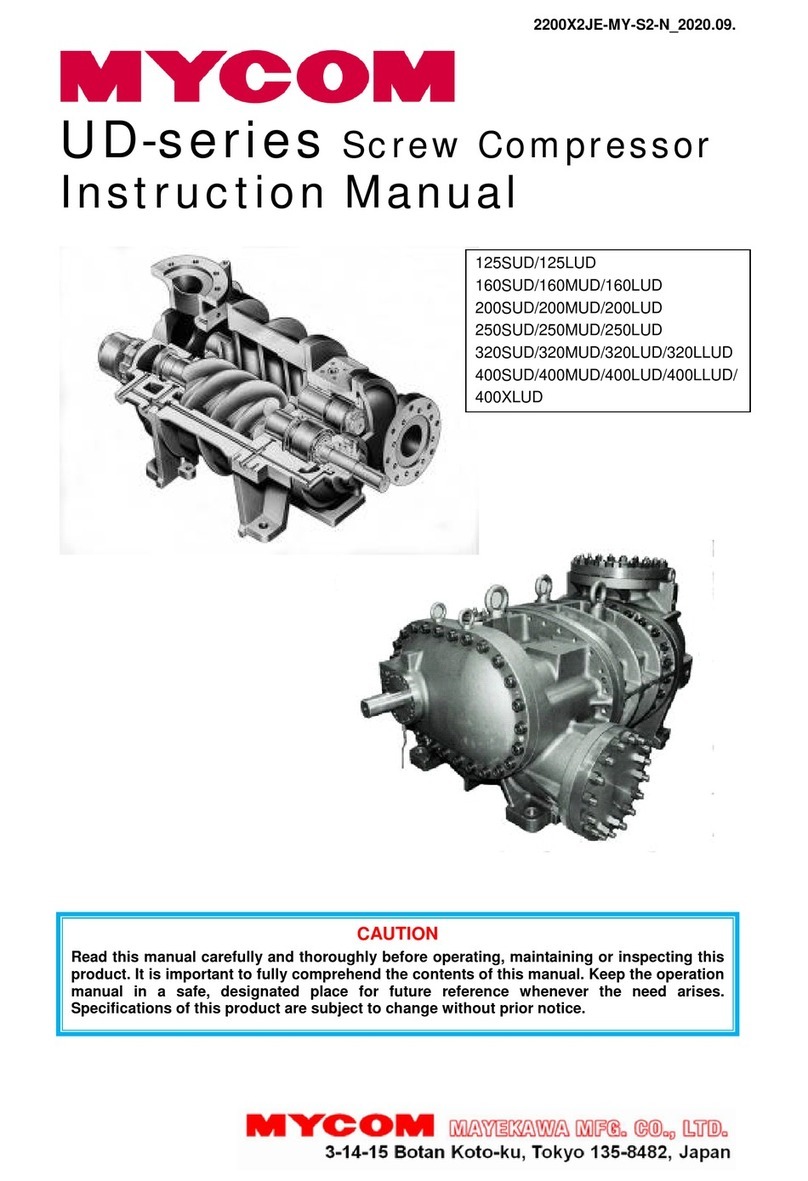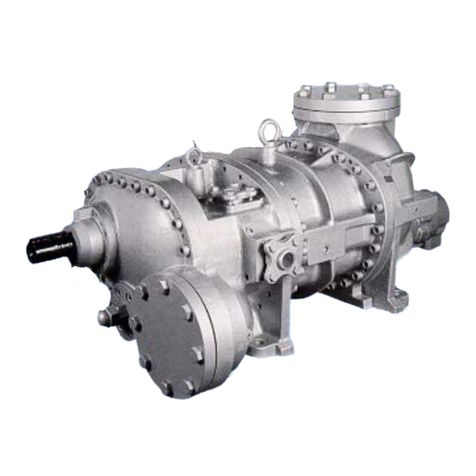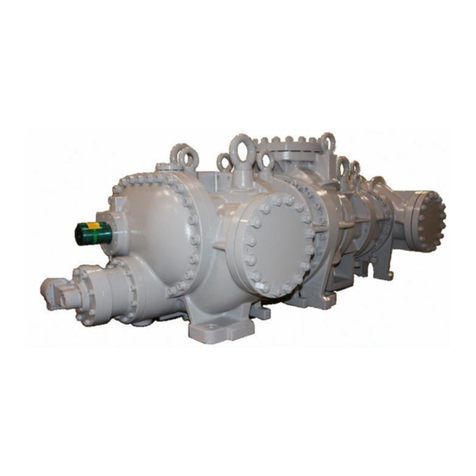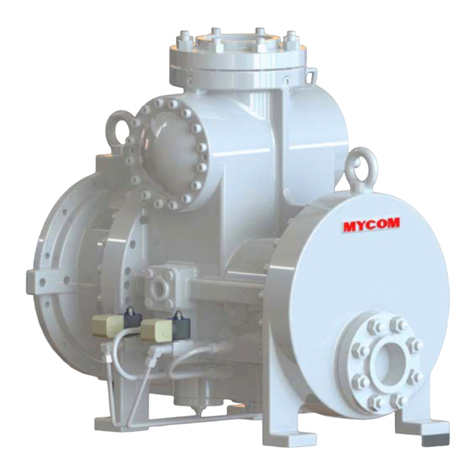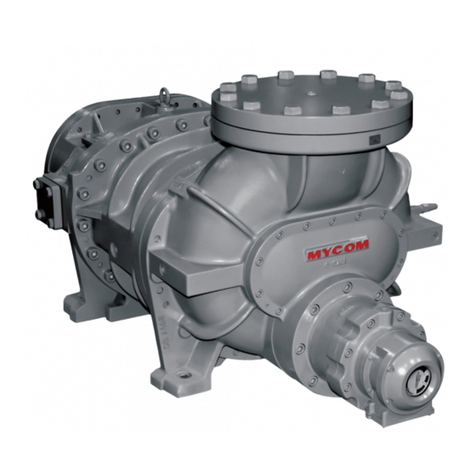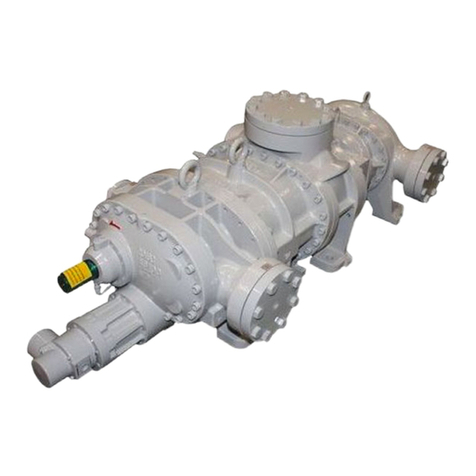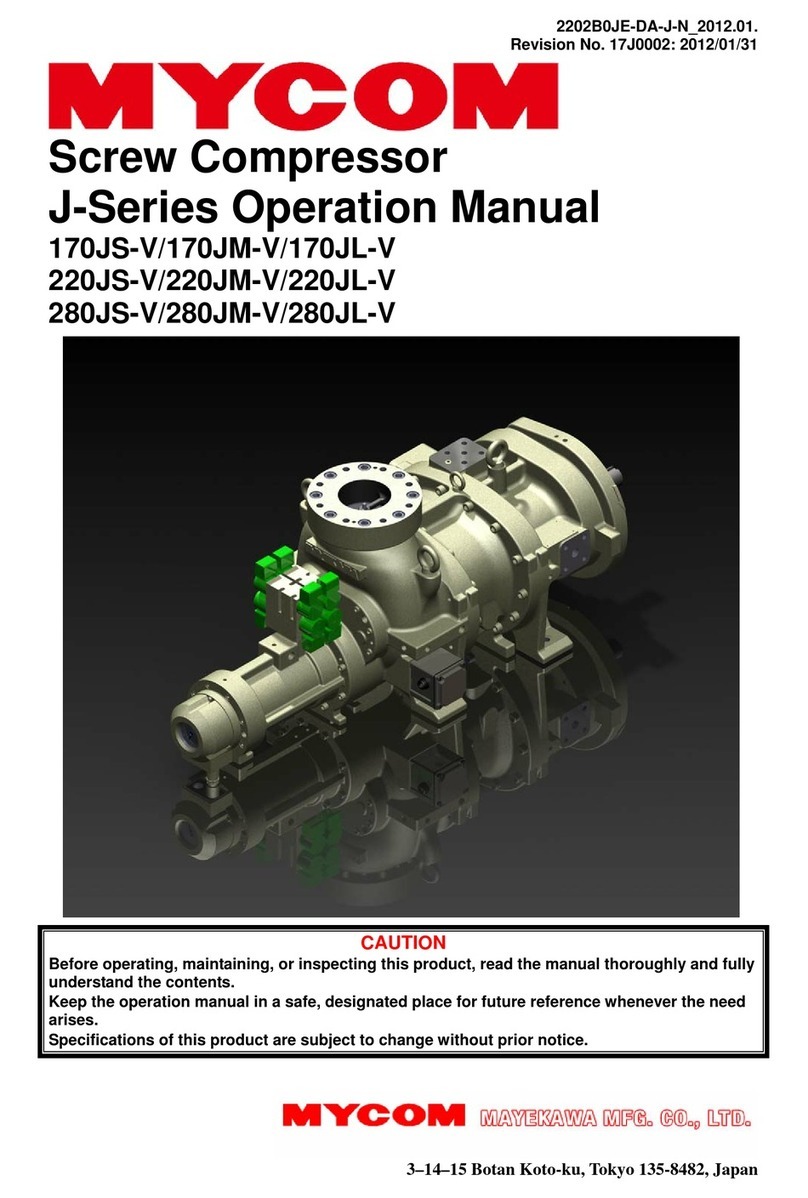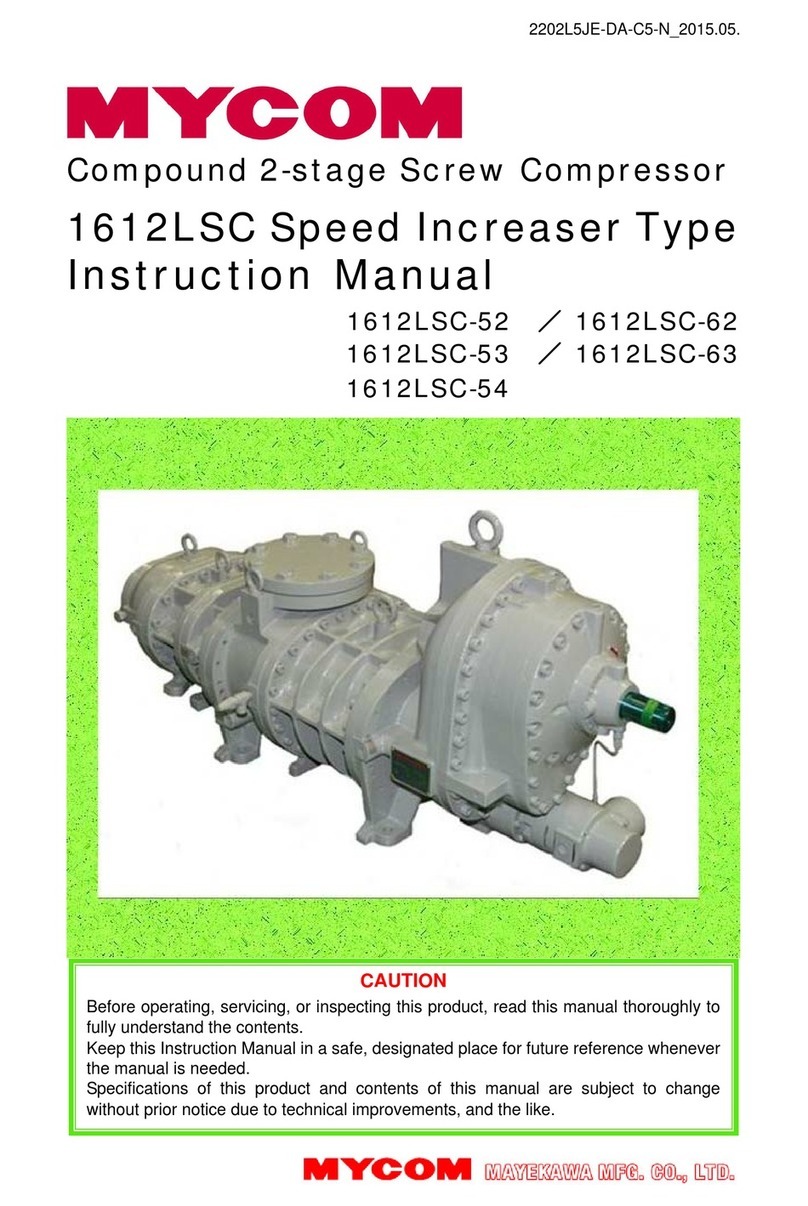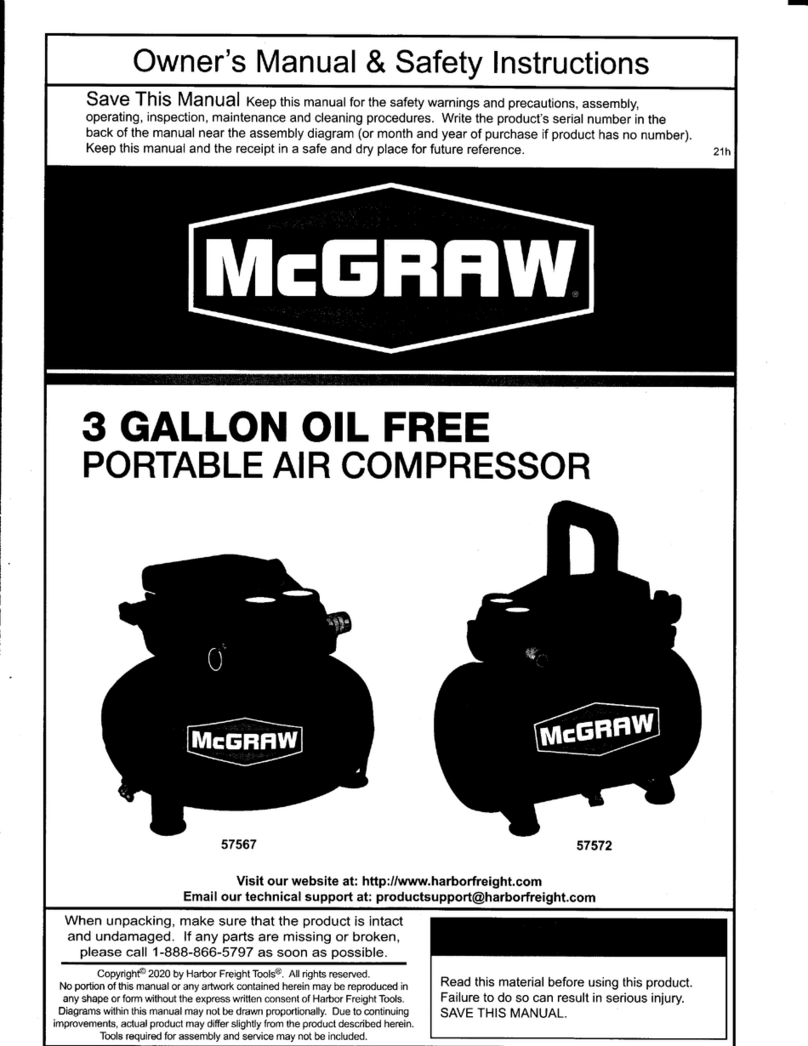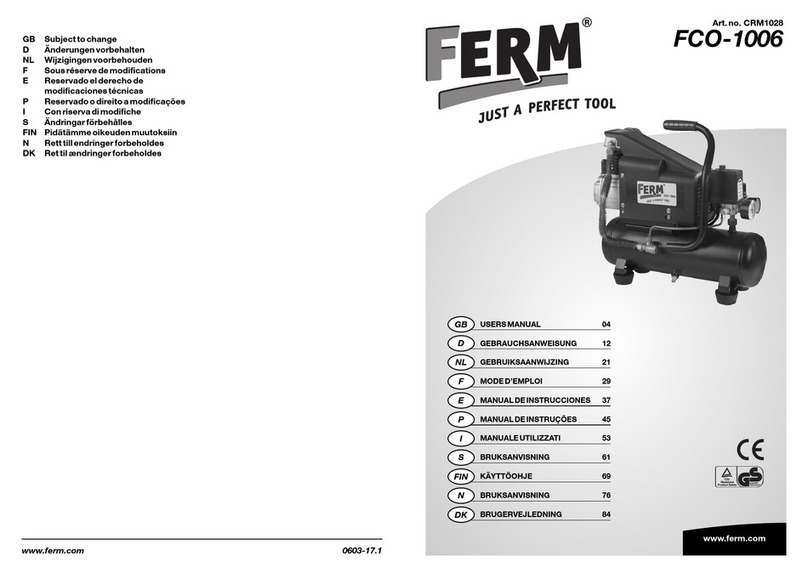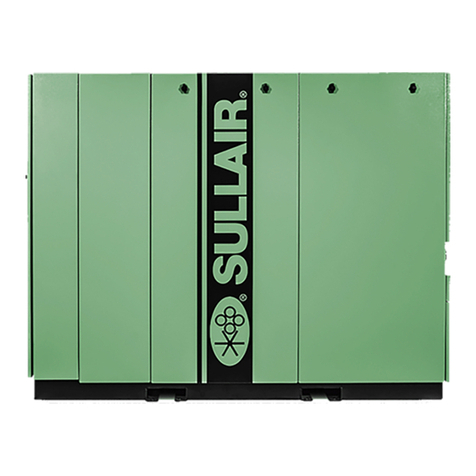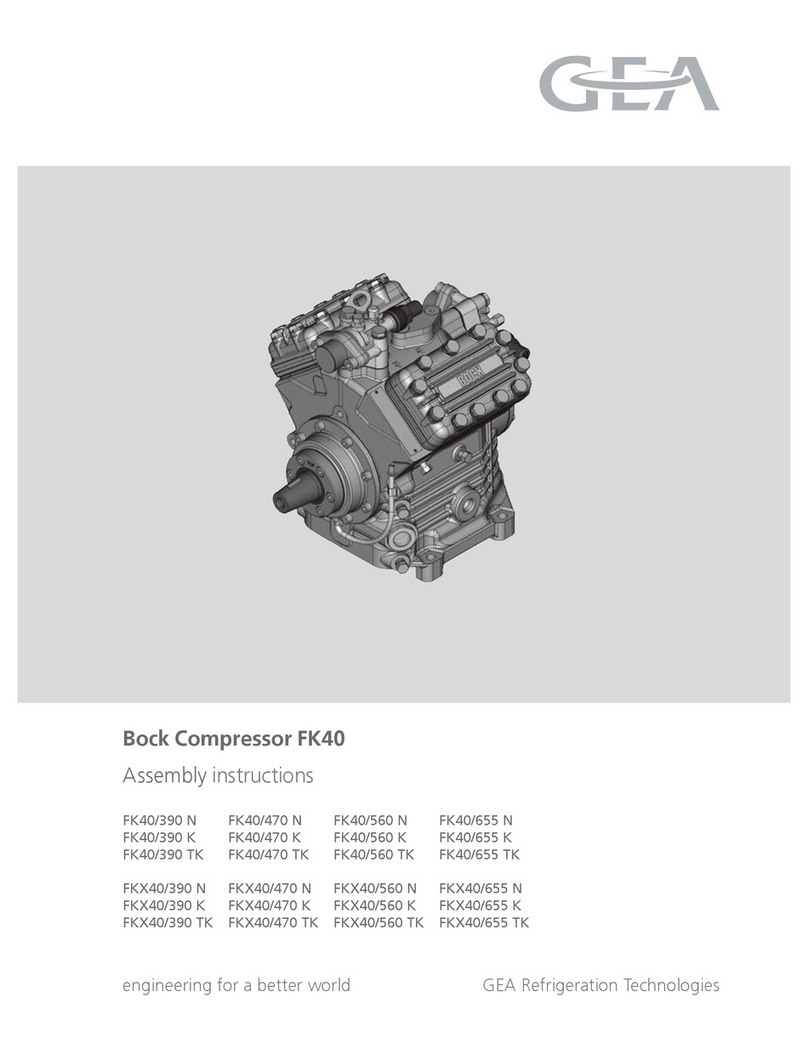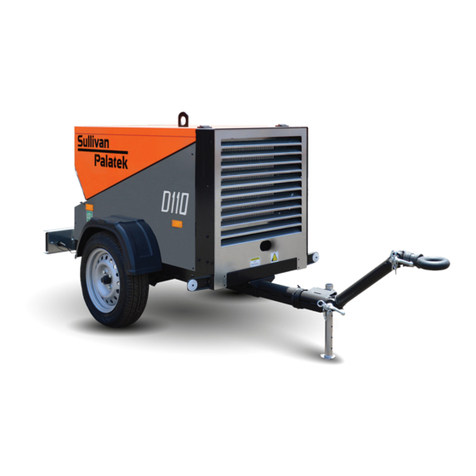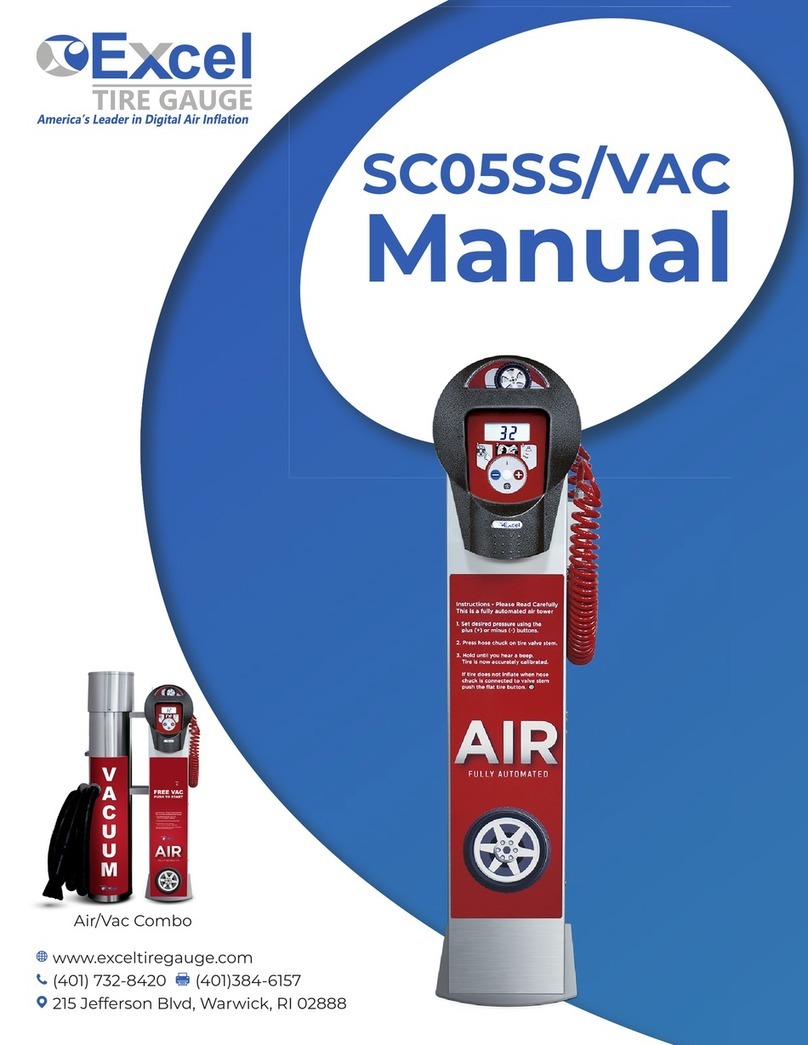mycom J Series User manual

2205B0JE-DA-J-N_2014.05.
3–14–15 Botan Koto-ku, Tokyo 135-8482, Japan
Screw Compressor
J-Series Instruction Manual
170JS-V/170JM-V/170JL-V
220JS-V/220JM-V/220JL-V
280JS-V/280JM-V/280JL-V
CAUTION
Before operating, maintaining, or inspecting this product, read the manual thoroughly and fully
understand the contents.
Keep the operation manual in a safe, designated place for future reference whenever the need
arises.
Specifications of this product are subject to change without prior notice.

2205B0JE-DA-J-N_2014.05.
Preface
Screw Compressor J-series
i
Preface
Thank you for purchasing this J-series/screw compressor (hereinafter indicated as "this
product").
This instruction manual (hereinafter indicated as "this manual") describes safety information,
operational and maintenance procedures in detail for safe and effective use of this product、and applies
to the following types.
170JS, 170JM, 170JL, 220JS, 220JM, 220JL, 280JS, 280JM, 280JL
Before installing or using this product, make sure you read this manual.
Keep this manual in a safe place near the product for quick reference.
Revision History
Instruction manual name Document No. First edition issue date
J-Series Instruction manual 2205B0JE-DA-J-N_2014.05. 2009.10.01
Revision
No. Issuance
Date Contents of revisions Created/
approved by:
17J0001 2010.03.15 Corrected editing error of Vi Position Sensor. Kobayashi
17J0002 2012.01.31 Addition of 220J/280J-series Kobayashi / Muta
03 2014.03.27 Revision by lubricating method change, other Muta/ Hirao
04 2014.04.25 Replaced Figure 2-1, changed the unit of motor
rotation speed to SI-unit Ikehara / Muta
05 2014.05.21 Corrected the description shortage of oil
filter requirements at Section 3.2.5.3 Ikehara/ Kubota

2205B0JE-DA-J-N_2014.05.
Warranty and Disclaimer
Screw Compressor J-series
ii
Warranty and Disclaimer
Warranty Clauses
If malfunctions or damages occur under proper usage and conditions following documents such as
specifications or instruction manual of this product, or, if MAYEKAWA judges that malfunctions or
damages are related to design or manufacture of the product, and if the malfunctions or damages are
within the warranty period, we will repair or replace the product without any charges.
The warranty period is “12 months from factory shipment of this product”. If use of this product is
governed by any other contracts, they will be given priority.
Disclaimer Clauses (Exclusion of Warranty Clauses)
Please note that we disclaim any responsibility for damage or malfunction to this product, as described
in the following items.
Malfunction or damage of this product caused by natural disaster, or other accidental forces
(such as windstorm, intense rainfall, flood, tidal wave, earthquake, land subsidence,
thunderbolt, fire, etc.).
Malfunction, damage, or defect to this product due to abnormal or improper use (such as
storing this product outdoors or in locations subject to high temperatures and high humidity,
unexpected inspections, tests, operations, and excessive repetition of start-up/stoppage of the
product.).
Malfunction or damage caused by devices or equipment not provided by MAYEKAWA including
operation control methods of those devices.
Malfunction or damage caused by refrigerants, gases, or lubricants not approved for this
product.
Malfunction or damage caused by maintenance or inspection not recommended by
MAYEKAWA.
Malfunction or damage caused by parts that are not MAYEKAWA genuine.
Malfunction or damage caused by remodeling the product without the approval of MAYEKAWA.
Direct or indirect production warranty or all other related warranties that arose due to
malfunction or damage of this product.

2205B0JE-DA-J-N_2014.05.
Important Information
Screw Compressor J-series
iii
Important Information
Intended Use of This Product
This product is a general-purpose screw compressor intended for refrigeration and cold storage.
Do not use the product for any purposes for which it was not intended or which depart from the
specifications. For specifications of this product, refer to “2.3 Compressor Specifications”.
The maintenance items described in this manual should be performed safely and closely following
procedures.
Important Information for Safe Use of This Product
Although MAYEKAWA has paid a lot of attention to safety measures for this product, all hazards
including potential hazards caused by human errors, or due to environmental conditions can not be
anticipated.
There are guidelines that must be observed for operating this product. However, the warnings in this
manual and safety labels on the product are not all inclusive. When operating this product, pay extreme
caution on personnel safety as well as on items described in this manual.
Important rules for safety work with the product that apply to all workers including managers and
supervisors are listed below.
Before using this product, carefully read and fully understand the contents written in this manual and
pay attention to safety.
Operation, maintenance, and inspection of this product should be performed by qualified
personnel educated about the fundamentals of the product and trained about hazards involved
and measures to avoid danger.
Do not allow any person other than those educated on the fundamental expertise of the
product and trained about hazards involved and measures to avoid dangers to approach the
product while it is operating or during maintenance.
Observe all related federal/national and local codes and regulations.
To prevent accidents, do not carry out any operation or maintenance other than those
described in this manual, or use the product for any unapproved purpose.
Replace the parts with the genuine parts.
Not only workers but also managers should actively participate safety and health activities in
the workplace to prevent accidents.
When closing or opening valves during work, apply lockout/tagout without failure, to prevent the
valves from closing or opening accidentally during the work.
[Lockout] To lock with a key in order to keep people, except the workers involved, from
operating the product.
“Lockout” means disconnecting or keeping disconnected machines and devices by locking their energy
(power) sources. Lockout is not just simply turning off the power switches to stop the supply of power,
but includes immobilizing them with a key or similar device to keep any blocked switches from being
operated.
Lockout devices are devices such as keys, covers, and latches, to immobilize switches, valves,
opening and closing levers, etc., with a state of being locked.
[Tagout] To prevent any inappropriate work by hanging tag plates indicating “work in progress”.
“Tagout” means to clearly indicate, by hanging tag plates, that a device is in lockout and that operation
of the device is prohibited. Tag plates forbidding operation, starting, opening, etc. are warnings clearly
stating to not operate energy (power) sources, and are not for stopping blocking devices.

2205B0JE-DA-J-N_2014.05.
Important Information
Screw Compressor J-series
iv
Observe the following precautions when performing maintenance work on electrical control.
Electrical maintenance of the product must be performed by certified/qualified personnel and
only those educated about the electrical control of the product.
Before servicing or inspecting the electrical equipments or devices, turn "OFF" the motor main
power and control power, and perform lockout/tagout to prevent the power from being turned
on during work.
Even when the motor main power and control power are turned "OFF", this product may be turned on if
the power is supplied from outside the refrigeration system, cold storage, and air conditioning unit.
Make sure the power supply on the power source side is shut off, and perform lockout/tagout to prevent
the product from being turned on during work.
About This Manual
This product may be modified without prior notice. Therefore, the appearance of actual
machine may differ from the descriptions in this manual. If you have any questions contact your
sales offices or service centers.
This manual is in English. If any other language is required it is the customers responsibility to
prepare a manual for safety education and operation instructions.
This manual is copyrighted. Drawings and technical references including this manual shall not,
in whole or part, be copied, photocopied, or reproduced into any electronic medium or
machine-readable form without prior permission from MAYEKAWA.
Photographs or drawings included in this manual may differ from the appearance of actual
product.
If this manual is lost or damaged, immediately place a purchase order to your local sales office
or service center for a new manual. Using the product without the manual may result in safety
issues.
If you resell the product, never fail to attach this manual to the product.
Construction of This Manual
Title of section and
chapter Description details
Preface Describes the outline of this manual and how to read the manual.
Warranty and Disclaimer Describes clauses and coverage of warranty.
Exemption of warranty clauses is described as disclaimer.
Important Information Describes important information related to this product and this
manual.
1. Safety Describes safety information for the worker, safety rules for this
product, and management details regarding work safety required
for handling the product.
2. Structure and Specifications
of the Compressor Describes the main components of this product, functional
information, specifications, and operating limits.
3. Installation Describes installation procedure of this product.
4. Compressor and Package
Operation Describes precautions for operating this product.
5. Maintenance and Inspection Describes sections and period for inspecting, disassembly and
assembly of the product.
6. Troubleshooting Describes troubleshooting methods for the product in case
problems occur during operation of the product.
7. Related Documents Describes documents such as illustrated parts breakdown and
parts list.
Appendix Describes tips for design, manufacturing, and installation of the
compressor package.
Contact Information Describes contact information for our local sales offices or service
centers, which are for ordering genuine parts.

2205B0JE-DA-J-N_2014.05.
Table of Contents
Screw Compressor J-series
v
Table of Contents
Preface .................................................................................................................... ⅰ
Revision History..................................................................................................... ⅰ
Warranty and Disclaimer....................................................................................... ⅱ
Important Information............................................................................................ ⅲ
Intended Use of This Product ...........................................................................................ⅲ
Important Information for Safe Use of This Product ..........................................................ⅲ
About This Manual.............................................................................................................ⅳ
Construction of This Manual ..............................................................................................ⅳ
Table of Contents................................................................................................... ⅴ
1 Safety
1.1 Observation/Prevention ..............................................................................1-1
1.1.1 Observance (Do's)............................................................................................1-1
1.1.1.1 Do's on Operation........................................................................................1-1
1.1.1.2 Do's on Maintenance...................................................................................1-1
1.1.1.3 Do's on Lockout/Tagout after Shutting off the Power .................................. 1-2
1.1.1.4 Do's about Personal Protective Gear..........................................................1-2
1.1.1.5 Do's about Handling of Hazardous and Toxic Substances..........................1-2
1.1.1.6 Do's about Handling Emergency Situation.................................................. 1-2
1.1.1.7 Do's about Waste Oil, Fluid, and Materials .................................................1-2
1.1.1.8 Other Do's.................................................................................................... 1-3
1.1.2 Prohibition (Don'ts)...........................................................................................1-3
1.2 Warnings.......................................................................................................1-4
1.2.1 Types and Meanings of Warnings.................................................................... 1-4
1.2.2 Safety labels..................................................................................................... 1-4
1.3 Residual Risks .............................................................................................1-7
1.4 Safety Devices............................................................................................1-10
1.4.1 Emergency Stop Button..................................................................................1-10
1.4.2 Breakers of Main Motor Power and Control Power
(Use of Lockout/Tagout Devices)...................................................................1-10
1.4.3 Compressor Protection Devices.....................................................................1-11
2 Structure and Specifications of the Compressor
2.1 Features of the J-Series Screw Compressor.............................................2-1
2.2 Model Designation of the Compressor......................................................2-1
2.3 Compressor Specifications ........................................................................2-2
2.3.1 Specifications.................................................................................................... 2-2
2.3.2 Operation Limits................................................................................................2-5
2.3.3 Outer Dimensions............................................................................................. 2-7
2.4 Structure of the Compressor....................................................................2-14
2.4.1 Sectional View................................................................................................ 2-15

2205B0JE-DA-J-N_2014.05.
Table of Contents
Screw Compressor J-series
vi
2.5 Mechanisms ...............................................................................................2-24
2.5.1 Basics of the Screw Compressor ...................................................................2-24
2.5.2 Suction Process.............................................................................................. 2-25
2.5.3 Compression Process ....................................................................................2-25
2.5.4 Discharge Process..........................................................................................2-25
2.6 Oil Flow.......................................................................................................2-26
2.7 Capacity Control Characteristics .............................................................2-27
2.8 Variable Vi Control.....................................................................................2-28
2.8.1 Vi (Internal Volume Ratio) ..............................................................................2-28
2.8.2 Reasons for Adjusting Vi According to Operating Conditions........................2-29
2.8.3 Details of Variable Vi Mechanism................................................................... 2-29
2.8.3.1 Automatic Variable Vi Mode ......................................................................2-29
2.8.3.2 Fixed Vi Mode............................................................................................2-30
2.8.4 Vi Position Sensor .......................................................................................... 2-30
2.9 Solenoid Valve ...........................................................................................2-31
2.9.1 170J/220J-series ............................................................................................ 2-31
2.9.2 Explosion Proof for 170j/220J-series, Also 280J-series.................................2-33
3 Installation
3.1 Precautions for Installation.........................................................................3-1
3.2 Installation Work..........................................................................................3-2
3.2.1 Unpacking.........................................................................................................3-2
3.2.2 Storage.............................................................................................................3-2
3.2.3 Transfer ............................................................................................................3-2
3.2.4 Preparation for Installation................................................................................ 3-3
3.2.5 Installation......................................................................................................... 3-4
3.2.5.1 Installation....................................................................................................3-4
3.2.5.2 Piping...........................................................................................................3-5
3.2.5.3 Equipment and Devices for Protection of the Compressor......................... 3-6
3.2.6 Pressure Test (Leak Test)................................................................................ 3-7
3.2.7 Lubricant(Refrigerant Oil) Charge ....................................................................3-7
3.2.7.1 Initial Charge of Lubricant............................................................................3-7
3.2.7.2 Additional Charge of Lubricant Procedure ..................................................3-8
3.2.8 Charging of Refrigerant.................................................................................... 3-8
3.2.9 Check after Installation.....................................................................................3-8
3.3 Documents Related to Installation.............................................................3-9
4 Compressor and Package Operation
4.1 Adjustment before Test Operation.............................................................4-1
4.1.1 Adjustment of Unloader Slide Valve and Variable Vi Slide Valve.................... 4-1
4.2 Lubricant (Refrigerant Oil) ..........................................................................4-2
4.2.1 Precautions for Selecting the Lubricant............................................................ 4-2
4.2.2 Recommended Lubricant .................................................................................4-2
4.2.3 Change of Lubricant Brand...............................................................................4-4
4.2.4 Precautions for Handling Lubricant .................................................................. 4-4
4.2.4.1 Precautions for Handling Polyalkylene Glycol (PAG)..................................4-4

2205B0JE-DA-J-N_2014.05.
Table of Contents
Screw Compressor J-series
vii
4.2.4.2 Precautions for Handling Polyolester (POE) Oil.......................................... 4-5
4.3 Precautions for Operation...........................................................................4-6
4.3.1 Prevention of Liquid Return (Liquid Backflow) Operation.................................4-6
4.3.2 Purging of Non-condensable Gases.................................................................4-6
4.4 Action for Stopping the Compressor for Long Period of Time ...............4-7
5 Maintenance and Inspection
5.1 Precautions for Maintenance and Inspection............................................5-1
5.2 Maintenance List..........................................................................................5-2
5.2.1 Daily Management............................................................................................5-2
5.2.2 Periodical Inspection......................................................................................... 5-5
5.2.3 Guidelines for Compressor Overhaul Frequency.............................................5-6
5.2.4 Replacement Parts of the Compressor in Overhauling.................................... 5-7
5.3 Management of Lubricant .........................................................................5-18
5.3.1 Lubricant Management Standard...................................................................5-18
5.3.2 Replacement Interval for Lubricant.................................................................5-19
5.3.2.1 First system startup...................................................................................5-19
5.3.2.2 During normal operation............................................................................ 5-19
5.4 Disassembly and Assembly of the Compressor.....................................5-20
5.4.1 Tools for Disassembly and Work Place..........................................................5-20
5.4.2 Replacement Parts.........................................................................................5-20
5.4.3 Recovering the Refrigerant.............................................................................5-20
5.4.4 Removing the Compressor.............................................................................5-21
5.4.5 Removing Oil from Inside the Compressor ....................................................5-22
5.4.6 Common Work Items...................................................................................... 5-23
5.4.7 Vi Position Sensor .......................................................................................... 5-25
5.4.7.1 Common Precautions for Removal/Installation.........................................5-26
5.4.7.2 Precautions for Removal...........................................................................5-26
5.4.7.3 Precautions for Installation........................................................................ 5-26
5.4.8 Seal Cover......................................................................................................5-27
5.4.8.1 Common Precautions for Removal/Installation.........................................5-29
5.4.8.2 Precautions for Removal...........................................................................5-29
5.4.8.3 Precautions for Installation........................................................................ 5-30
5.4.9 Bearing Cover................................................................................................. 5-31
5.4.9.1 Common Precautions for Removal/Installation.........................................5-32
5.4.9.2 Precautions for Removal...........................................................................5-32
5.4.9.3 Precautions for Installation........................................................................ 5-33
5.4.10 Unloader Indicator/Capacity Control Solenoid Valve ..................................... 5-34
5.4.10.1 Precautions for Removal...........................................................................5-35
5.4.10.2 Precautions for Installation........................................................................5-35
5.4.11 Unloader Cover...............................................................................................5-36
5.4.11.1 Common Precautions for Removal/Installation.........................................5-38
5.4.11.2 Precautions for Removal........................................................................... 5-38
5.4.11.3 Precautions for Installation........................................................................5-39
5.4.12 Unloader Cylinder...........................................................................................5-42
5.4.12.1 Common Precautions for Removal/Installation.........................................5-43
5.4.12.2 Precautions for Removal...........................................................................5-43

2205B0JE-DA-J-N_2014.05.
Table of Contents
Screw Compressor J-series
viii
5.4.12.3 Precautions for Installation........................................................................5-44
5.4.13 Vi Cylinder ......................................................................................................5-45
5.4.13.1 Common Precautions for Removal/Installation.........................................5-47
5.4.13.2 Precautions for Removal...........................................................................5-47
5.4.13.3 Precautions for Installation........................................................................5-47
5.4.14 Balance Piston Cover.....................................................................................5-48
5.4.14.1 Common Precautions for Removal/Installation.........................................5-49
5.4.14.2 Precautions for Removal...........................................................................5-49
5.4.14.3 Precautions for Installation........................................................................5-49
5.4.15 Suction Cover.................................................................................................5-50
5.4.15.1 Common Precautions for Removal/Installation.........................................5-52
5.4.15.2 Preparation for Suction Adapter Removal.................................................5-52
5.4.15.3 Precautions for Removal...........................................................................5-52
5.4.15.4 Precautions for Installation........................................................................5-53
5.4.16 Thrust Bearings ..............................................................................................5-54
5.4.16.1 Precautions for Removal...........................................................................5-56
5.4.16.2 Precautions for Installation........................................................................5-56
5.4.17 Separation of Suction Cover and Main Rotor Casing.....................................5-58
5.4.17.1 Common Precautions for Removal/Installation.........................................5-59
5.4.17.2 Precautions for Removal...........................................................................5-59
5.4.17.3 Precautions for Installation........................................................................5-59
5.4.18 Suction Cover.................................................................................................5-60
5.4.18.1 Common Precautions for Removal/Installation.........................................5-60
5.4.18.2 Precautions for Removal...........................................................................5-61
5.4.18.3 Precautions for Installation........................................................................5-61
5.4.19 Rotors.............................................................................................................5-62
5.4.19.1 Common Precautions for Removal/Installation.........................................5-63
5.4.19.2 Precautions for Removal...........................................................................5-63
5.4.19.3 Precautions for Installation........................................................................5-64
5.4.20 Separation of Bearing Head and Main Rotor Casing.....................................5-65
5.4.20.1 Precautions for Removal...........................................................................5-66
5.4.20.2 Lifting of Bearing Head.............................................................................. 5-66
5.4.20.3 Lifting of Main Rotor Casing......................................................................5-66
5.4.20.4 Precautions for Installation........................................................................5-65
5.4.21 Bearing Head..................................................................................................5-67
5.4.21.1 Common Precautions for Removal/Installation.........................................5-67
5.4.21.2 Precautions for Removal...........................................................................5-68
5.4.21.3 Precautions for Installation........................................................................5-68
5.4.22 Suction Adapter (except for 280J)..................................................................5-69
5.4.22.1 Common Precautions for Removal/Installation.........................................5-70
5.4.22.2 Precautions for Removal...........................................................................5-71
5.4.22.3 Precautions for Installation........................................................................5-71
5.4.23 Unloader Slide Valve Guide ...........................................................................5-72
5.4.24 Adjustment of End Clearance......................................................................... 5-73
5.4.25 Inspection for Runout Male Rotor Shaft .........................................................5-75
5.4.26 Inspection for Runout of Seal Cover Mount Face (Bearing Cover)................ 5-75
6 Troubleshooting
Table 6.1 Troubleshooting .............................................................................................. 6-1

2205B0JE-DA-J-N_2014.05.
Table of Contents
Screw Compressor J-series
ix
7 Related Documents
7.1 Development View and Configuration Table of the Parts........................7-1
7.2 List of Tightening Torques for Bolts and Nuts........................................7-22
7.3 List of Tools for Disassembly...................................................................7-27
7.4 Design Modification Notification (follow-up)...........................................7-28
Appendix 1 Tips for Design, Manufacturing, and Installation of
the Compressor Package
Appendix 1.1 Precautions for Design of
the Compressor Package........................................... Appendix 1-1
Appendix 1.2 Tips for Compressor Package Manufacturing.......... Appendix 1-6
Appendix 1.3 Tips for Compressor Package Installation ............... Appendix 1-6
Contact Information

2205B0JE-DA-J-N_2014.05.
1 Safety
Screw Compressor J-series 1.1 Observation/Prevention
1-1
1 Safety
1.1 Observation/Prevention
1.1.1 Observance (Do's)
1.1.1.1 Do's on Operation
Always use the specified controller (CP4) designed for this product.
This controller protects the compressor utilizing sensor output values.
Make sure that all necessary safety devices are installed and the control values for machine
protection are set correctly.
Regularly inspect the safety devices and the controller's protective functions. Ensure that they
operate properly.
If the safety devices and the controller's protective functions do not work properly or the
machine operates abnormally, stop operation immediately and report the incident to your
supervisor. Do not restart the machine until the supervisor determines the machine safety and
provides proper instructions for restart.
If the machine stops due to unknown reasons, immediately inform your supervisor. Do not
restart the machine until the supervisor determines the machine safety and provides the proper
instructions for restart.
Some types of refrigerants generate bad smell or toxic gases and cause oxygen deficiency.
Make sure to ventilate the working area.
Some refrigerants and refrigerant oils may be corrosive, decomposable, or toxic. Make sure to
obtain the Safety Data Sheets (SDS) of the refrigerants and refrigerant oils and follow their
instructions.
When stopping the compressor for a long time, turn "OFF" the main motor, heater, and control
power. Close the suction and discharge side shut-off valves.
1.1.1.2 Do's on Maintenance
When performing work with at least two or more persons, thoroughly confirm the work
procedure and clearly understand each others work before commencement.
Always turn OFF and lockout /tagout the main motor, control and other devices before
troubleshooting, setup, cleaning, maintenance, or inspection of the compressor. Also, make
sure that those powers are NOT turned on accidentally during work.
Always confirm that the pressure inside the package (refrigerating/cold storage/ air
conditioning) is atmospheric before troubleshooting, setup, cleaning, maintenance or
inspection of the compressor.
Before troubleshooting, setup, cleaning, servicing or inspection of the compressor, apply
lockout/tagout or other equivalent measures to the liquid supply stop valves and valves in the
upstream and downstream of any opening so that the valves do not open accidentally during
the work.
Some types of refrigerants generate bad smell or toxic gases and cause oxygen deficiency.
Make sure to ventilate the air during work.
Some refrigerants and refrigerant oils may be corrosive, decomposable, or toxic. Make sure to
obtain the Safety Data Sheets (SDS) of the refrigerants and refrigerant oils and follow their
instructions.
After working on the machine, always store the tools used at the specified places and make
sure that no tools are left in or around the machine.

2205B0JE-DA-J-N_2014.05.
1 Safety
Screw Compressor J-series 1.1 Observation/Prevention
1-2
1.1.1.3 Do's on Lockout/Tagout after Shutting off the Power
Prepare lockout/tagout devices for the main breakers of the main motor and control power.
By applying lockout/tagout after shutting off the power, you can prevent any other personnel
from activating the machine (power) inadvertently and protect safety of the personnel working
inside the power supply equipment and the package.
If there are any possibilities of danger during work (especially during cleaning, maintenance,
inspection, or troubleshooting), turn "OFF" the main motor and control power, and perform
lockout/tagout.
Before entering the package for troubleshooting, setup, cleaning, or maintenance/inspection,
always apply lockout/tagout to the main motor and control power personally.
Shut off the power and perform lockout/tagout before entering the package. Clearly notify the
workers of the necessity of lockout/tagout.
It is assumed that workers do not perform lockout/tagout of the main motor and control
power before starting work because it is troublesome, and only turn "OFF" the main motor
and control power.
It is assumed that workers only turn off main motor and control power and do not
lockout/tagout the main motor and control power, because they think it is not important.
After checking that all the work is finished, the worker who applied lockout/tagout must release
them.
1.1.1.4 Do's about Personal Protective Gear
Prepare and use protective gear complying with the area’s safety standards.
Check the function of each protective gear before use.
Wear appropriate work cloth and avoid loose clothing.
Do not wear any neckties or jewelry that can get entangled in the moving or rotating parts. A
helmet is recommended to protect your head and hair.
Do not have anything in your pocket to prevent objects from falling into the machine.
1.1.1.5 Do's about Handling of Hazardous and Toxic Substances
Obtain Safety Data Sheets (SDS) from manufacturers of hazardous and toxic substances.
Check the SDS and follow the handling instructions recommended by the manufacturers to
handle and store those substances.
1.1.1.6 Do's about Handling Emergency Situation
Develop an emergency action procedure in accordance with the legal regulations and post it at
a safe place.
1.1.1.7 Do's about Waste Oil, Fluid, and Materials
Disposal of refrigerant and waste oil from the compressor are subject to a number of
regulations for environmental protection purposes. Follow the local, state or federal acts and
regulations as well as your company's rules, when disposing of such waste oil, fluid and
materials.

2205B0JE-DA-J-N_2014.05.
1 Safety
Screw Compressor J-series 1.1 Observation/Prevention
1-3
1.1.1.8 Other Do's
Keep the floor around the refrigerating, cold storage, and air conditioning packages clean and
provide a safety aisle.
Use only the safety aisle to move around the equipment. Keep the safety aisle free from any
tools and cleaning fluid.
If water or oil is spilled on the compressor or the floor, immediately wipe it off to prevent
workers from injury caused by slipping.
1.1.2 Prohibition (Don'ts)
Do not remove or relocate any safety devices, including electrical interfaces.
Do not disable any safety devices by short-circuiting or bypassing without any permission.
Do not leave the compressor unsafe and unattended, by removing the safety cover or some
other safety measures.
Do not touch, clean, or lubricate any part of the compressor especially moving parts when the
compressor is operating.
Do not touch relays or electric systems such as terminal block with bare hands when turning on
the power.

2205B0JE-DA-J-N_2014.05.
1 Safety
Screw Compressor J-series 1.2 Warnings
1-4
1.2 Warnings
To alert workers about possible dangers, the following two measures are always provided with the
compressor.
Warnings described in this manual
Safety labels affixed on the compressor
1.2.1 Types and Meanings of Warnings
This manual includes the following four types of warnings to be used for hazards during operation or
maintenance of the compressor.
Neglecting such warnings may cause accidents, resulting in personal injury or even death. Also, the
compressor or its auxiliary equipment may be heavily damaged. Therefore, be sure to always observe
the instructions of the warnings.
Table 1-1 Types and Meanings of Warnings in this manual
Warning Type Meaning
Indicates an imminently hazardous situation which, if not avoided, will result in
serious injury or death.
Indicates a potential hazardous situation which, if not avoided, could result in serious
injury or death.
Indicates a potential hazardous situation which, if not avoided, may result in minor or
moderate injury.
Indicates a potentially hazardous situation which, if not avoided, may result in
property damage.
1.2.2 Safety labels
The following shows the types of safety labels and their positions affixed on the compressor.
Always follow the warnings instructed on the safety label affixed on the compressor.
Be sure to follow the instructions of the safety labels. Otherwise, danger
resulting in personal injury, death, or property damage may arise.
Do not smear, cover, or peel off the safety labels.
If the safety labels are damaged or missing, purchase and affix new labels to their
proper positions according to this manual.
Inform our service centers of the product name and safety label number when placing a
purchase order for safety labels.

2205B0JE-DA-J-N_2014.05.
1 Safety
Screw Compressor J-series 1.2 Warnings
1-5
Types of Safety Labels
Table 1-2 Safety Label
No. Safety label Remarks
1
2

2205B0JE-DA-J-N_2014.05.
1 Safety
Screw Compressor J-series 1.2 Warnings
1-6
Affixing Positions of Safety Labels
The figure below shows the affixing positions of safety labels.
The numbers in the figure correspond to the ones in Table1-2 Safety Label.
Figure 1-1 Safety Label Locations (170J/220J)
Figure 1-2 Safety Label Locations (280J)

2205B0JE-DA-J-N_2014.05.
1 Safety
Screw Compressor J-series 1.3 Residual Risks
1-7
1.3 Residual Risks
The following information is provided on the assumption that this product is operated, inspected, and
maintained while being used in general refrigerating, cold storage, and air conditioning packages.
Note that all hazardous sources cannot be predicted for the applications mentioned.
Devise appropriate countermeasures for hazardous sources in your systems.
Table 1-3 Hazardous Sources
Danger source Predicted hazard Measures to be taken
in operation
Measures to be taken
when cleaning,
inspecting, and
replacing parts
A Motor and
compressor coupling
Entanglement caused
by contact Install coupling covers
and prohibit opening
Keep away
Shut off and
lockout/tagout of
motor’s main power
and control power
B Motor terminals Electric shock caused
by live wiring
contact and
electrical leakage
Keep away
Do not open terminal
box
Do not touch terminal
box
Shut off and
lockout/tagout of
motor’s main power
and control power
C Compressor suction
casing
Frostbite caused by
contact
Contact with or
inhalation of
hazardous
substances caused
by leaking
refrigerant, etc.
Keep away and do not
touch
Wear protective gear
Gas leakage detection
Wear protective gear
Work under normal
temperature
D Compressor
discharge casing
Burn caused by
contact
Contact with or
inhalation of
hazardous
substances caused
by leaking and
blowing off
refrigerant, etc.
Keep away and do not
touch
Wear protective gear
Sufficient ventilation
Gas leakage detection
Wear protective gear
Work in temperatures
below 40 °C
Appropriate refrigerant
handling
Sufficient ventilation
E Discharge piping
F Lubricating piping
and joints
G Package unit
Solenoid
valves/motorized
valves on each part
Electric shock caused
by live wiring
contact and
electrical leakage
Trapping caused by
contact with a drive
part
Install terminal
protective cover and
prohibit opening
Keep away and do not
touch
Wear protective gear
Shut off each breaker,
and shut off and
lockout/tagout the
control power
Wear protective gear

2205B0JE-DA-J-N_2014.05.
1 Safety
Screw Compressor J-series 1.3 Residual Risks
1-8
Danger source Predicted hazard Measures to be taken
in operation
Measures to be taken
when cleaning,
inspecting, and
replacing parts
H Package unit
Electric components
of each part (oil
heater, protective
switch, etc.)
Electric shock caused
by live wiring
contact and
electrical leakage
Burn caused by
contact
Install terminal
protective cover and
prohibit opening
Keep away and do not
touch
Wear protective gear
Shut off each breaker,
and shut off and
lockout/tagout the
control power
Wear protective gear
I
Package unit
Oil drains Contact with hazard-
ous substances
caused by leakage
and blowoff
Burn caused by
contacting with
high temperature
fluid
Sufficient ventilation
Keep away and do not
touch
Wear protective gear
Sufficient ventilation
Wear protective gear
Work in temperatures
below 40 °C
J Noises Hearing disabilities
caused by noises
Wear protective gear
—

2205B0JE-DA-J-N_2014.05.
1 Safety
Screw Compressor J-series 1.3 Residual Risks
1-9
Figure 1-3 Hazardous Sources (170J/220J)
Figure 1-4 Hazardous Sources (280J)

2205B0JE-DA-J-N_2014.05.
1 Safety
Screw Compressor J-series 1.4 Safety Devices
1-10
1.4 Safety Devices
For safe use and protection of the compressor, make sure to attach safety devices to the compressor
that comply with the regulations and the following descriptions.
Safety devices must be properly and periodically maintained and inspected. It is important to include
maintenance and inspection of safety devices in the periodical maintenance/inspection schedule. Make
sure to provide users of the compressor with necessary information on types, attachment positions,
functions, inspection method of the safety devices.
Check the safety devices after turning on the power and before operation of the
compressor. If they do not operate normally, immediately take measures to
replace them.
1.4.1 Emergency Stop Button
Overview/Function/Purpose
The emergency stop buttons are used to stop the compressor operation immediately if an
emergency occurs to the compressor.
Installation Locations
The emergency stop buttons should be installed in the controller on the compressor and in the
operating control room
Stop/Reset Methods
To activate and reset the emergency stop buttons, refer to the unit instruction manual.
Inspection Method/Cycle
The emergency stop buttons must be tested before a test run as well as periodically. For details
about the inspection procedure and inspection cycle of the emergency stop buttons, refer to the
unit instruction manual.
1.4.2 Breakers for the Main Motor Power and Control Power
(with Lockout/Tagout Devices)
Overview/Function/Purpose
Turn off the main motor and control power, and if there are any possibilities of danger during work
(especially during cleaning, maintenance, inspection, or troubleshooting), lockout/tagout devices
must be set up for breakers of the main motor and control powers to prevent injury to workers in
case the power is turned on accidentally during work.
Methods of Performing and Releasing Lockout/Tagout
In accordance with the regulations created by Occupational Safety & Health Administration
(OSHA) and other authorities, make sure to clearly indicate methods of performing and releasing
lockout/tagout and provide users of this compressor with the necessary information.
Inspection Method/Cycle
For inspection procedures and the inspection cycle of the lockout/tagout devices, refer to the unit
instruction manual.
Other manuals for J Series
1
This manual suits for next models
12
Table of contents
Other mycom Air Compressor manuals
Popular Air Compressor manuals by other brands
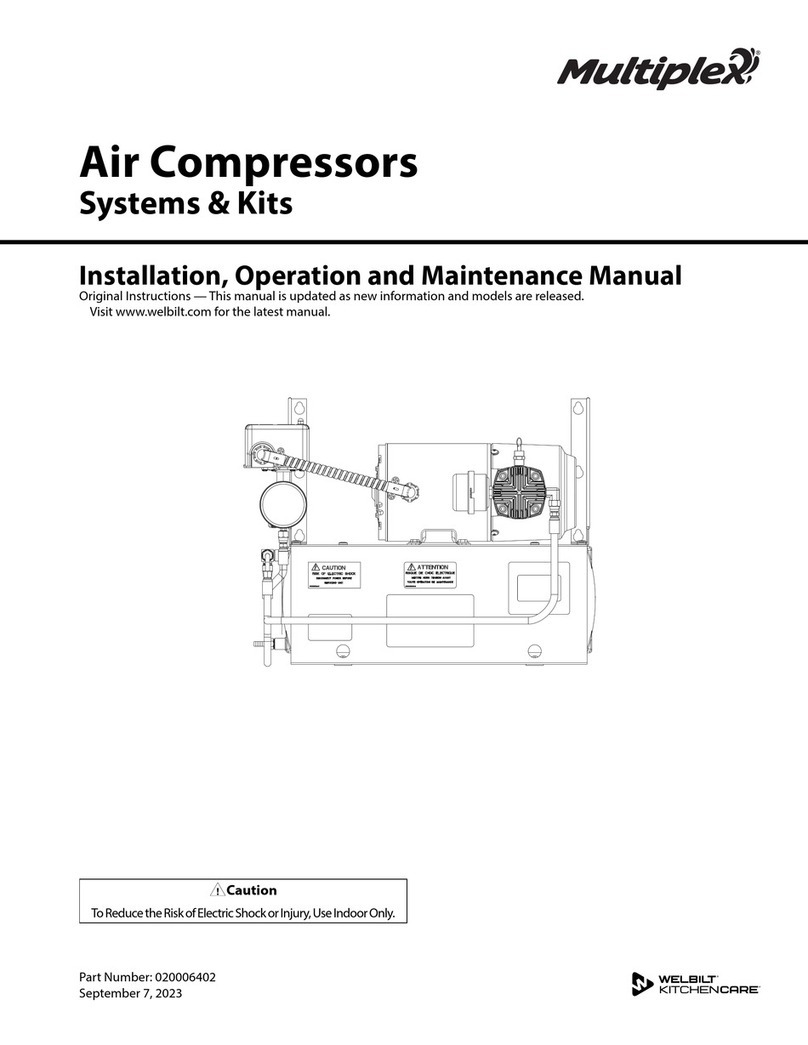
Welbilt
Welbilt Multiplex APKV3D Installation, operation and maintenance manual

Horn Tools
Horn Tools HCOMP050 operating instructions
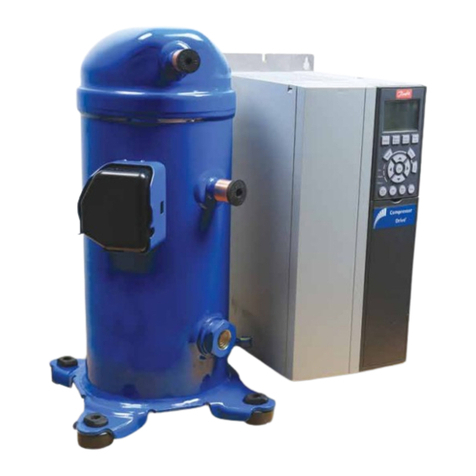
Danfoss
Danfoss VZH052 Series manual
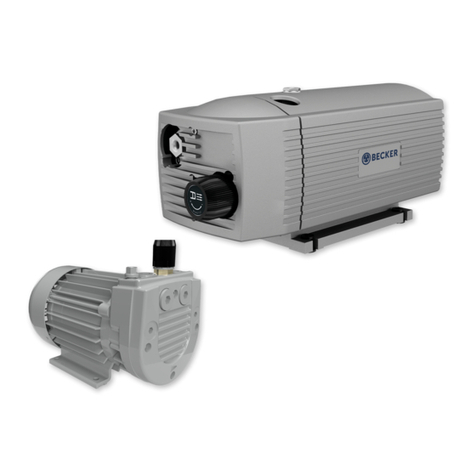
Becker
Becker DT 4.40/0-80 operating instructions
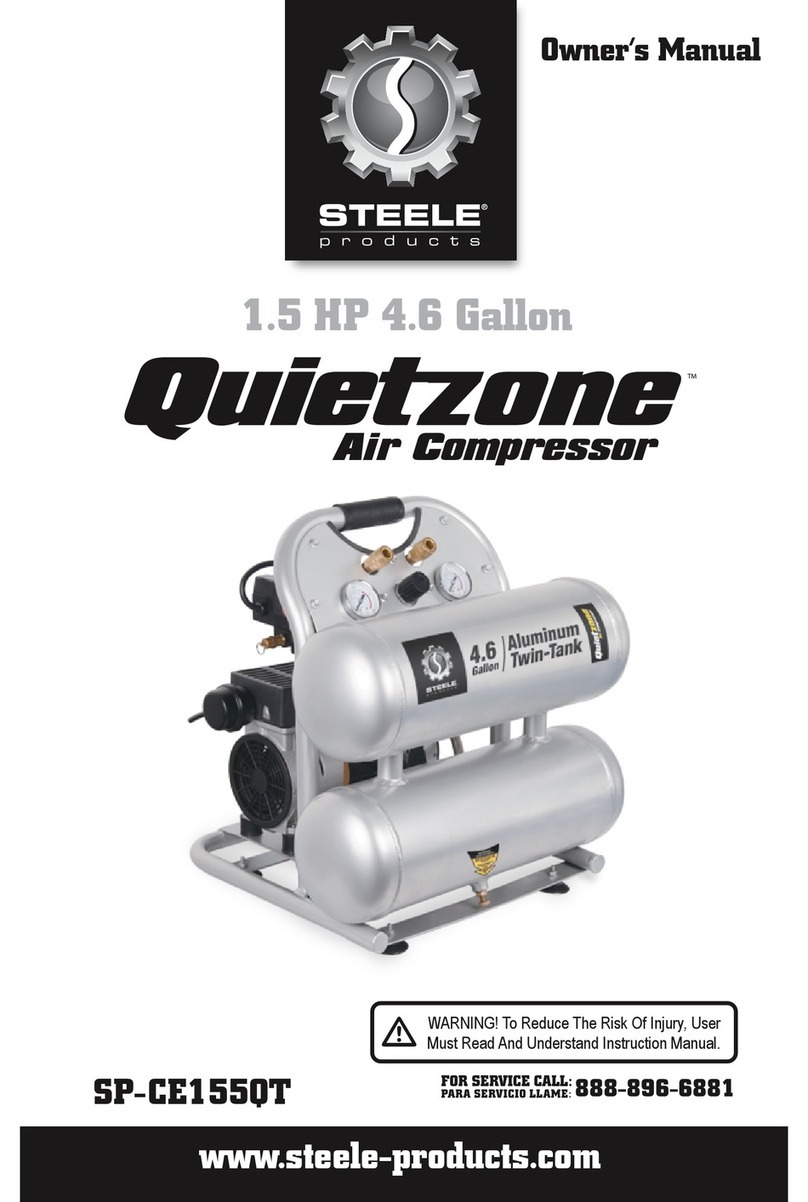
STEELE PRODUCTS
STEELE PRODUCTS Quietzone SP-CE155QT owner's manual

Ingersoll-Rand
Ingersoll-Rand CSAXHP1070WCAT operating & maintenance manual
